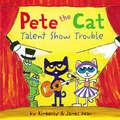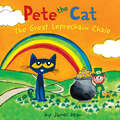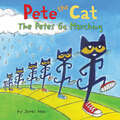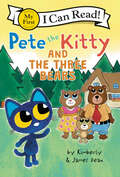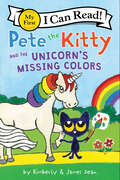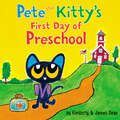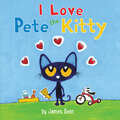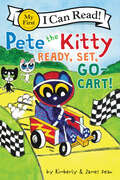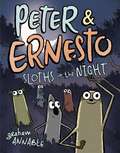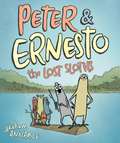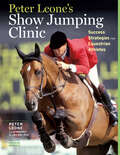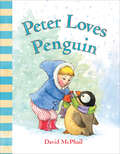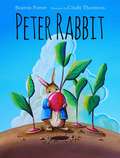- Table View
- List View
Pete the Cat: Super Pete (I Can Read Level 1)
by Kimberly Dean James DeanFrom New York Times bestselling creators Kimberly and James Dean, Pete the Cat becomes...Super Pete! We all need a superhero Pete in our life.When there's trouble in town, it’s up to Pete the Cat's alter ego, Super Pete, to save the day! With his cool jet, nifty goggles, and slick slingshot, Super Pete is ready to take down any bad guys.Pete the Cat: Super Pete is a Level 1 I Can Read book, which means it's perfect for shared reading with a child and any heroes-in-training.
Pete the Cat: Talent Show Trouble (Pete the Cat)
by Kimberly Dean James DeanRock out with Pete the Cat and Grumpy Toad in this brand-new book from New York Times bestselling author-illustrator team Kimberly and James Dean. Includes over 30 cool stickers!Pete the Cat’s school is hosting a fun talent show! Pete knows just what to sign up for—playing the guitar. But when he writes his name on the list, he is surprised to see Grumpy Toad also signed up for the same talent.Join Pete the Cat and Grumpy Toad as they learn about the importance of teamwork and friendship!
Pete the Cat: The Great Leprechaun Chase (Pete the Cat)
by Kimberly Dean James DeanNew York Times #1 Bestseller!New York Times bestselling author and artist James Dean takes us on a St. Patrick's Day adventure with Pete the Cat as Pete discovers how lucky he actually is!It's St. Patrick's Day, and it's also the grand opening of Pete the Cat's leprechaun catching business. Pete gears up to trap a leprechaun for his friends! But catching a leprechaun is never easy—especially if it’s Clover, who's full of tricks.Will luck be on Pete’s side? Or will Pete learn luck is actually something earned?
Pete the Cat: The Petes Go Marching (Pete the Cat)
by Kimberly Dean James Dean#1 New York Times bestseller James Dean puts a groovy spin to the classic children’s song “The Ants Go Marching" with everyone's favorite cool cat. Join Pete the Cat as he rocks out to this classic tune with a supercool twist in this paper-over-board picture book.Your child, or even your classroom of children, is sure to want to march along with Pete, 1, 2, 3!
Pete the Cat: The Wheels on the Bus (Pete the Cat)
by Kimberly Dean James DeanPete the Cat leads kids back to school with this fun version of the classic song.Pete the Cat can't wait to take the school bus all the way to school! Everyone's favorite cat is groovier than ever in this way-cool adaptation of the classic kids' song "The Wheels on the Bus."The kitties on the bus say, "Come on, Pete! Come on, Pete!" The kitties on the bus say, "Conme on, Pete! Hop on board!"New York Times bestselling artist and author James Dean adds a groovy vibe to his cool adaptation of "The Wheels on the Bus" with Pete the Cat. Hop on board with Pete and his friends as they sing the classic school bus tune. Fans of Pete the Cat will love singing along with Pete in this groovy rendition of this favorite children's song.
Pete the Cat: Three Bite Rule (Pete the Cat)
by Kimberly Dean James Dean Anne LambBased on the Amazon Prime Video original series that was inspired by the classic bestselling picture book series!Pete the Cat is whipping up a delicious dish for his class’s potluck. Pete can’t wait to share his banana casserole with his classmates. It’s his favorite lunch!But it turns out that his friend Grumpy Toad hates bananas. How can he hate bananas if he's never tried one before? Pete shows Grumpy trying something new can be supercool and groovy with the “Three Bite Rule.”This brand-new Pete the Cat picture book retells groovy moments from the show!
Pete the Cat: Too Cool for School (My First I Can Read)
by Kimberly Dean James DeanIf you want to be cool, just be YOU! That's the message of this funny, relatable Pete the Cat school story—and kids will laugh and agree.Pete the Cat can't decide what to wear to school in Pete the Cat: Too Cool for School. With so many groovy options to choose from, Pete just keeps adding on.All of Pete's friends have a suggestion for what he should wear to school. But by the time he's added cowboy boots, shorts with fish, his red shirt AND his yellow shirt—and even more—he's too hot.It's time to make his own clothing decisions and head back to school! You and your kids will giggle at Pete and his clothing choices, resolved with a positive empowering message.Pete the Cat: Too Cool for School is a My First I Can Read book. Each My First I Can Read book is carefully crafted using basic language, word repetition, sight words, and sweet illustrations—which means it's perfect for shared reading with emergent readers. The active, engaging My First I Can Read stories have appealing plots and lovable characters, encouraging children to continue their reading journey.
Pete the Cat: Twinkle, Twinkle, Little Star (Pete the Cat)
by Kimberly Dean James DeanJoin Pete in New York Times bestselling artist James Dean's Pete the Cat picture book series as he stars in the classic nighttime song "Twinkle, Twinkle, Little Star." Pete the Cat fans new and old will delight as Pete sings about the stars up above in this rendition of a favorite children's bedtime song.
Pete the Cat: Valentine's Day Is Cool (Pete the Cat)
by Kimberly Dean James DeanNew York Times bestselling author and artist James Dean takes us on an awesome trip with Pete the Cat as he discovers just how special Valentine's Day can be!At first, Pete thinks Valentine's Day isn't cool...until he realizes all the special cats there are in his life.Once Pete the Cat realizes how much fun Valentine’s Day can be, he decides to make valentine cards for his family and friends. But what happens when he realizes he's forgotten to make a card for a very important cat?
Pete the Kitty and the Case of the Hiccups (My First I Can Read)
by Kimberly Dean James DeanBeginning readers will laugh and easily relate to Pete the Kitty and his search for the perfect remedy for his hiccups!Pete gets a case of the hiccups, and he doesn’t know what to do. He decides to ask his wisest friends for help, like Grumpy Toad, Callie, and Bob. But Pete is still stuck with the hiccups. Will Pete the Kitty ever get rid of his terrible hiccups?This My First I Can Read book is carefully crafted using basic language, word repetition, sight words, and sweet illustrations—which means it's perfect for shared reading with emergent readers. The active, engaging My First I Can Read stories have appealing plots and lovable characters, encouraging children to continue their reading journey.This is the very first Pete the Kitty I Can Read favorite from New York Times bestselling Pete the Cat author-artist James Dean!
Pete the Kitty and the Groovy Playdate (Pete the Cat)
by Kimberly Dean James DeanThis groovy series from New York Times bestselling team James and Kimberly Dean introduces Pete the Cat before he was Pete the Cat...when he was little Pete the Kitty! Pete the Kitty is super excited to visit his friend Grumpy Toad’s house for a playdate! Grumpy Toad has all the best toys: a truck, building blocks, and a superhero cape. Far out! It’s going to be cat-tastic!But when Grumpy Toad refuses to share any of his cool toys with Pete, neither of them are having any fun. Will Grumpy Toad ever share his toys with his friend Pete?In this easy-to-read and engaging picture book, little readers will learn all about sharing with their favorite blue kitten!
Pete the Kitty and the Mermaid's Sandcastle (My First I Can Read)
by Kimberly Dean James DeanA magical mermaid adventure from New York Times bestselling creators Kimberly and James Dean!Pete the Kitty and his mermaid friend Jessie work together to build a sandcastle. But the castle is missing something. Will one shell, two barnacles, three strands of seaweed, and more gifts from the sea be enough to make their sandcastle the best it can be?Young mermaid fans and beachgoers will love building and counting with Pete and Jessie in this My First I Can Read story, complete with original illustrations from the creator of Pete the Cat, James Dean.This My First I Can Read book is carefully crafted using basic language, word repetition, sight words, and sweet illustrations—which means it's perfect for shared reading with emergent readers. The active, engaging My First I Can Read stories have appealing plots and lovable characters, encouraging children to continue their reading journey.
Pete the Kitty and the Three Bears (My First I Can Read)
by Kimberly Dean James DeanJoin Pete the Kitty as he visits the three bears in this I Can Read story from New York Times bestselling team Kimberly and James Dean.Once upon a time, there was a kitty named Pete who came upon a house in the forest. He goes in, eats pizza, plays guitar, and falls asleep. But what happens when three bears come home?Beginner readers will love this new Pete-tastic spin on the beloved fairy tale Goldilocks and the Three Bears!This My First I Can Read book is carefully crafted using basic language, word repetition, sight words, and sweet illustrations—which means it's perfect for shared reading with emergent readers. The active, engaging My First I Can Read stories have appealing plots and lovable characters, encouraging children to continue their reading journey.
Pete the Kitty and the Unicorn's Missing Colors (My First I Can Read)
by Kimberly Dean James DeanA magical unicorn adventure from New York Times bestselling creators Kimberly and James Dean!Pete the Kitty's friend Stevie the unicorn somehow lost all the colors in her rainbow tail. It’s a good thing Pete has his magical paintbrush to help out. Together, they search for the missing colors of the rainbow.Young unicorn fans will love Pete's enchanting adventure in this My First I Can Read story, complete with original illustrations from the creator of Pete the Cat, James Dean.My First I Can Read books are perfect for shared reading with a child. Books at this level feature basic language, word repetition, and whimsical illustrations, ideal for sharing with emergent readers. The active, engaging stories have appealing plots and lovable characters, encouraging children to continue their reading journey.
Pete the Kitty's First Day of Preschool (Pete the Cat)
by Kimberly Dean James DeanPete the Kitty is almost ready for his first day of preschool! Preschoolers and little ones getting ready to go to preschool for the first time will enjoy cheering Pete the Kitty's fun entry to preschool.It's a big day for Pete the Kitty: his first day of preschool! He meets his cool teacher, sings a few fun songs, and even gets to paint. Who knew preschool could be so much fun?Just don't forget your groovy backpack and your yummy snack, Pete the Kitty!Little ones will enjoy exploring what the first day of school is like with Pete the Kitty.
Pete the Kitty's Outdoor Art Project (My First I Can Read)
by Kimberly Dean James DeanJoin Pete the Kitty as he gets creative in this I Can Read story from New York Times bestselling team Kimberly and James Dean.Pete the Kitty loves art class. But when the project is to go outside and make art from nature, Pete isn’t sure what to create. Then inspiration strikes and Pete realizes that nature art is cooler than he ever imagined!Beginner readers will love creating nature art with Pete!This My First I Can Read book is carefully crafted using basic language, word repetition, sight words, and sweet illustrations—which means it's perfect for shared reading with emergent readers. The active, engaging My First I Can Read stories have appealing plots and lovable characters, encouraging children to continue their reading journey.
Pete the Kitty: I Love Pete the Kitty (Pete the Cat)
by Kimberly Dean James DeanNew York Times bestselling author-illustrator James Dean introduces young readers to Pete the Cat before he was Pete the Cat...when he was little Pete the Kitty!Pete the Kitty loves so many wonderful things in life—like birthday cake, ice cream, his guitar, and more.But what does this groovy kitty love the most? Find out in this board book!Makes a good stocking stuffer, and for any moment you want to express your love, from Mother's Day and Father's Day to Valentine's Day!
Pete the Kitty: Ready, Set, Go-cart! (My First I Can Read)
by Kimberly Dean James DeanFrom New York Times bestselling author/illustrator team Kimberly and James Dean comes a new I Can Read story featuring everyone’s favorite kitty, Pete the Kitty! Pete the Kitty is excited to build his very own go-cart. But things don’t go as planned. Turns out, his go-cart is missing a few important things. Thankfully, Bob and Gus are there to help Pete out! Beginning readers will love reading about Pete the Kitty’s fun go-cart adventure! My First I Can Read books are perfect for shared reading with a child.This My First I Can Read book is an excellent choice to share at home or in the classroom, in particular for children ages 3 to 5. It’s a fun way to learn to read and as a supplement for activity books for children.
Pete the Kitty: Wash Your Hands (My First I Can Read)
by Kimberly Dean James DeanJoin Pete the Kitty as he learns to wash his hands in this new I Can Read story from New York Times bestselling creators Kimberly and James Dean!Splish, scrub, splash, rub! Keeping clean is groovy and fun!Pete must wash his hands many times a day. He must wash them after he sneezes, coughs, plays with his friends, eats his food, and throws away his trash.Beginning readers will love learning how to wash their hands with Pete!This My First I Can Read book is carefully crafted using basic language, word repetition, sight words, and sweet illustrations—which means it's perfect for shared reading with emergent readers. The active, engaging My First I Can Read stories have appealing plots and lovable characters, encouraging children to continue their reading journey.
Peter & Ernesto: Sloths in the Night (Peter & Ernesto #3)
by Graham AnnableFrom Box Trolls director Graham Annable comes Peter & Ernesto: Sloths in the Night, an immensely charming new addition to his brilliant graphic novel series about the endearing friendship between two sloths.Peter and Ernesto love the jungle, but they know how dangerous it can be at night. From clumsy bats to crazed owls to rumors of a dragon, there are countless things that make the darkness perilous for sloths.That’s why, one day, when their friend Bernard goes missing just as the sun is setting, Peter and Ernesto quickly gather their tribe to form a search party. However, while these sloths have some sense of the dangers that they’ll face while looking for Bernard, there are surprises lurking in the shadows that will surpass their wildest imaginings!
Peter & Ernesto: The Lost Sloths (Peter & Ernesto #2)
by Graham AnnableFrom Box Trolls director Graham Annable comes Peter & Ernesto: The Lost Sloths, the immensely charming sequel to his brilliant debut graphic novel about the endearing friendship between two sloths.Peter and Ernesto loved their tree. Then a hurricane came and blew it away! Now, Peter, Ernesto, and the rest of their sloth friends must venture into the jungle to find a new—great—tree. But the jungle is full of dangers, including angry ants, slithering snakes, and a ravenous jaguar!Can cautious Peter and confident Ernesto work together to keep their tribe safe? They’ll have to, if they want to find the perfect tree to call home!
Peter Duck
by Arthur RansomeSeries: Swallows and Amazons series ; 03 In the third book of the adventures of the Walker and Blackett children, Peter Duck carries them onto the high seas. In their search for hidden treasure, under the command of the infamous Captain Flint (Uncle Jim), they brave fog, sharks, a real-life pirate, and ravenous crabs. Sequel to "Swallowdale." For grades 4-7 and older readers.
Peter Leone's Show Jumping Clinic: Success Strategies for Equestrian Competitors
by Kimberly S. Jaussi Peter LeoneSharing wisdom gained through decades of riding at the highest levels of competition, Olympic medalist Peter Leone shows you how to achieve jumping success. Covering the fundamental principles of jumping, this guide stresses solid riding mechanics and the importance of a respectful friendship between horse and rider. With focused exercises that are designed to improve both the physical skills and mental toughness required for equestrians of all levels, you&’ll learn how to bring out the best in your horse and successfully reach your riding goals.
Peter Loves Penguin (David McPhail's Love Series)
by David McPhailPeter and Penguin wake up to snow on the ground and immediately get bundled up to play outside. After making snowballs and a snowman and enjoying the perfect winter day together, they return inside to warm up and share some cocoa. In this companion to Ben Loves Bear and Bella Loves Bunny, the youngest readers will relate to the loving bond between a little boy and his favorite stuffed animal, and how this sweet friendship makes each day special.
Peter Rabbit (First Avenue Classics Ser. #No. 1)
by Beatrix Potter Cindy ThorntonThe basis for the 2018 film, Peter Rabbit has been hailed as one of the bestselling stories of all time and has been adapted into countless mediums, including books, films, board games, coloring books, and more. The original story features a young rebellious rabbit who, despite his mother’s wishes, enters the dangerous garden of Mr. McGregor to feast on its endless bounty. From there on out, he gets himself into all kinds of trouble. Originally published as separate stories throughout the early twentieth century, this updated 2018 edition features vibrant, all-new illustrations by renowned contemporary artist Cindy Thornton that are sure to captivate the sensibilities of the modern audience. Follow the exciting adventures of Peter Rabbit, one of literature’s favorite furry friends.

